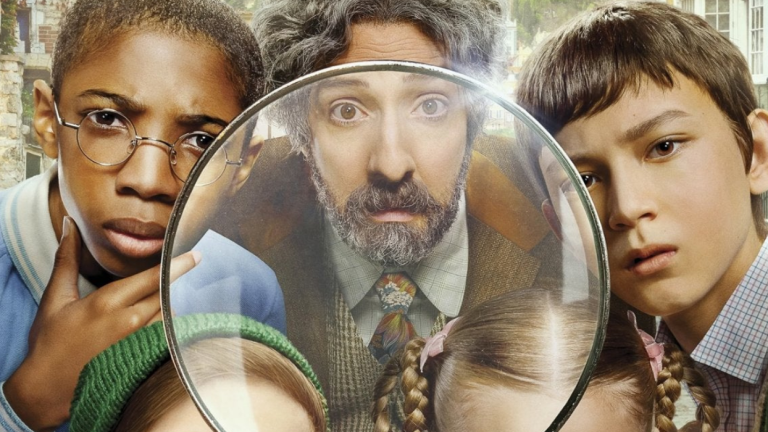The Mysterious Benedict Society: Bringing the Middle Grade Mystery Series to TV
Mysterious Benedict Society series creators Phil Hay and Matt Manfredi discuss their journey through development hell and the pandemic to premiere day.

This article contains spoilers for the first two episodes of The Mysterious Benedict Society plus teasers for future episodes. There are no book spoilers beyond the plots featured in the first two episodes.
The Mysterious Benedict Society is not only Disney+’s latest television series, it’s one of the streamer’s noteworthy original TV projects outside the massive Marvel and Star Wars franchises… But that doesn’t mean it doesn’t have a source material. The series is based on the bestselling middle grade book series by Trenton Lee Stewart. Stewart first published The Mysterious Benedict Society in 2007, which means the original readers are now adults and even parents themselves. (I myself discovered the series while working in summer camp and after school a year or two after publication.) The series was in development hell for over a decade before Phil Hay and Matt Manfredi joined the project in 2017. Den of Geek talked to series creators Hay and Manfredi, who previously worked on AEon Flux and the Ride Along movie series together, to discuss the behind the scenes of translating this middle grade mystery adventure to the silver streaming screen.
“We were aware of the book when we were brought them, and read the first one and just fell in love,” Manfredi tells Den of Geek. The most important example of this love comes through in novel series author Stewart signing on as consulting producer on the series. Several other middle grade books from the mid 2000’s, most notably the Percy Jackson movies, were reduced to in-name-only movie adaptations that butchered the essence of the stories, due to authors having no input on the adaptation.
“We talked to him very early in the adaptation process, got to know him,” Hay says. ”Then as the show went along, he read all the scripts, he saw the cuts…whenever he had an idea, it obviously rang a lot of bells for us… and, it was just very important to us that he be pleased and like it.”
The series follows Mr. Benedict (Tony Hale), a scientist living in an alternate universe who is very concerned that the world’s increased anxiety, called The Emergency, is not, in fact, the organic result of social politics, but rather is being orchestrated by someone outside the government. There are subliminal messages about The Emergency broadcast across the media and adults have accepted these messages as truth. Kids are naturally more curious and at times confrontational about accepting authority and fate. Although Mr. Benedict has two extremely capable assistants in Rhonda Kazembe (MaameYaa Boafo) and Number 2 (Kristen Schaal); he needs children to infiltrate the educational institute from which the messages about The Emergency originate. After a series of rigorous tests, he assembles a team of four extremely smart orphans to infiltrate and to find the person responsible. Renard “Reynie” Muldoon (Mystic Inscho) is a master puzzle solver, George “Sticky” Washington (Seth Carr) is a trivia champion, Kate Weatherall (Emmy DeOlivera) is a budding engineer and meteorologist, and Constance Contraire (Marta Kessler) is a social rebel who needs a cause to properly apply her truth-seeking instincts. The mission is going to test not only their skills but also their stamina to resist the subliminal messaging. The title of the series comes from the team name the children give themselves.
Although the adventure elements are clearly targeted towards today’s preteens, the political undertones of the story are definitely going to be the element that appeals to adults who haven’t read the novel series. “The book feels prescient,” Hay says. “I double-checked the copyright page when I was reading it because it just seemed that the themes were so resonant and relevant to today.” This theme adds depth and immediacy to the children’s mission. Adults will immediately recognize current politics in this alternate universe where the language of The Emergency is the language of misinformation.
Kids are also affected by the political situation around them and this renders the plot of The Mysterious Benedict Society relatable. “We have kids thinking of the way they’ve experienced the recent past as a relentless tide of anxiety, and how do we get to the bottom of that and how do we find ways to contend with it?” Hay says. “I think the message of the show in a way, is through getting to the truth and through finding the truth and then also through addressing others with care and with empathy and with kindness, and those things coalesced to be the bedrock of what we think the show is about.” Although some may feel uneasy about a dystopian alternate universe as escapist entertainment especially for children, there is hope and a solution embedded into the mission. The audience naturally roots for Mr. Benedict and his team triumph over evil.
Bringing the alternate universe of Stonetown and its environs to life from Stewart’s imagination presented several challenges for Hay and Manfredi. Shooting eight, hour-long episodes during the pandemic added considerable complexity to the project. “We had such an incredible team in Vancouver led by Grace Gilroy, our line producer, and the dedication of the cast and crew, which was extraordinary to keep each other safe and healthy and follow the protocols to the T all of which happened,” Hay says. “Every day when you’re shooting in that condition is seen as a gift, and you are just really reliant on everybody, every single member of the cast and crew to be vigilant and they were, and that’s something that is extremely inspiring.”
Another obstacle was reconciling viewers’ imaginations and the illustrations in the novels with the screen. “I imagined [the novel as] a bit more Gothic or Victorian, and partially just because it worked with the themes for us and partially because we thought a lot of other things have explored that visual landscape,” Hay says. “[We] settled on this idea that this could be told in a sixties, European modernist kind of vibe, where things are very organized and formal.”
That mention of other things exploring “a Victorian landscape” is an illusion to Netflix’s series adaptation of A Series of Unfortunate Events. Most adult viewers new to the series will likely make that comparison, since both series revolve around orphans fighting eccentric adult villains in a dystopian alternate universe. However, the first two episodes of The Mysterious Benedict Society make it clear that the main characters are fighting evil on the societal level versus an inheritance fraud conspiracy one.
Ironically, Tony Hale directly links the two series. He played Jerome Squalor in A Series of Unfortunate Events, and ended up being the top choice to lead The Mysterious Benedict Society. “We were such fans of Tony, and every role he’s done becomes an iconic thing,” Manfredi says. “He’s just so funny, and he had such a soulfulness to him and intelligence and compassion to him that he just kind of ticked all the boxes.” Hay added, “In the book, the character is reasonably a bit older. It’s more of a practical grandfatherly character than a fatherly character.” Mr. Benedict in the series is still eccentric, epilectic and tireless in his quest to right the wrongs in his world. At the end of Episode 2, the audience realizes Hale is pulling double duty in the series. He plays the sketchy institute headmaster and series villain L.P. Curtain. “We always saw it as a dual role, and that’s why somebody who is as versatile as Tony was, was so appealing to us,” Manfredi says. Novel readers know Mr. Benedict and Mr. Curtain are twin brothers. Hale makes a strong impression as Mr. Benedict in his introduction, and the challenge for the kids to figure out Mr. Curtain begins.
Along with the set design and Catherine Adair’s (recently known for costuming The Man In The High Castle and Fate: The Winx Saga) vintage kitschy costumes, casting is also a key part of distinguishing The Mysterious Benedict Society from other series. Reynie, Sticky, Kate and Constance in the books were characters not only defined by their intelligence but also for their innate sense of the truth in an uncertain world. “When we were casting with the kids, it was important to us to find old souls.” Manfredi said.
One of the most appealing factors to me as a reader over a decade ago was how Stewart’s vision of Stonetown had diverse representation built into the story. On the other hand, the adaptation of A Series of Unfortunate Events used raceblind casting to offset the white main characters Lemony Snicket (Daniel Handler) originally described. Episode 1 of The Mysterious Benedict Society brings this to the screen by introducing Reynie as a Latine boy learning Tamil from his teacher Miss Perumal (Gia Sandhu). “We were very, throughout the process really, really focused on diversity and inclusion in the cast, Hay says. “We were really hoping to find a diverse Reynie and Sticky … We wanted Sticky to be an African-American actor.” Although racism in the world of Stonetown works slightly differently than in ours, neither character is isolated from others who look like them.
One of the kids had an unintentional shift in their heritage. “In the book, Constance Contraire is not Russian, but when we saw Marta’s audition, she illuminated parts of the character for us, and we all of a sudden just couldn’t see her any other way,” Manfredi says. Fans should be reassured despite this accent shift Constance in the first two episodes is still the obstinate, headstrong, and full of haterade little girl readers know and love.
This vision was also carried out in the casting of the adult characters in the series. “Rhonda Kazembe is such a huge part of the book and of the show, even a bigger part of the show than the book,” Hay says. “To find MaameYaa was such a gift, but yeah, that was really on top of our mind, and then throughout the rest of the show, again, from the perspective of wanting the show to look like the world and seeing it as an opportunity to really create a world that does reflect the world around us.” In order to fulfill this objective, a shift in the storytelling was required. In the novel, once the kids arrive at the mysterious island institute, all of the action revolves around the children. “It was important to us to keep the adults involved, to create a kind of parallel storyline to have that back and forth with the kids and the adults and learn from each other along the way, and solve the mystery together.” Manfredi says.
What can viewers expect from the remaining six episodes? Stopping Mr. Curtain’s evil propaganda campaign is the conclusion the series is leading to. “We hope that over the course of the season, there’s going to be a lot of twists and turns and hopefully it’ll be a lot of fun,” Manfredi says. “[Hopefully] these themes of empathy and the importance of truth and being able to look at a problem in many different ways…[will] resonate, and hopefully they have fun with it.”
There are three books total in the series, plus a prequel about Mr. Benedict, but the fate of the series is out of the hands of Hay and Manfredi. For those who want to see the series continue, word of mouth online and offline will be key to get middle schoolers to watch and for adults to sign onto a nostalgia trip.
The first two episodes of The Mysterious Benedict Society will be available on Disney + on June 25th followed by one new episode every Friday.
